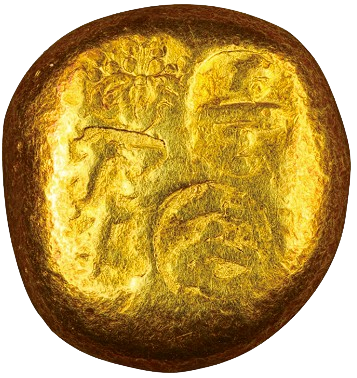Kōshū Ryō Kin
(甲州両金)


(Ginza Coins Collection, Tokyo. Reproduction authorized. © All rights reserved.)
Koshu Ichi Ryō Kin (甲州一両金), or Tsuyu Ichi Ryō (露一両), are gold coins of one ryō issued between the Tenshō period (1573–1592) and the early Edo era. Their shape, resembling a "dew drop," reflects the manual production methods of the time. They belong to the Ko Kōshūkin, with an average weight of 15.2 grams. Minted between 1578 and 1609 in the Kai region (present-day Yamanashi), these coins feature inscriptions such as 「金吉」(Kinkichi), 「上字」(Jōji), and 「甲」(Kō), indicating mints or quality. The Paulownia seal (桐紋, Kiri-mon), a symbol of Kai, guaranteed their authenticity. A rare variant, the Koma Ichi Ryō (駒一両), is adorned with a stylized horse, a symbolic or toponymic reference. Few specimens survive, preserved in private or museum collections.
| Coin Name | Kōshū Ryō Kin |
| Japanese Inscription | 甲州両金 |
| Historical Period | Sengoku Period (1467 –1603 d.C.) Edo Period (1603-1868 d.C.) |
| Year of Minting | 1578–1609 d.C. |
| Chronological Reference | Kai Province (Koshu), post-Takeda period |
| Minting Location | Koshu (Kai) |
| Issuing Authority | Tokugawa Clan / Post-Takeda Transition Period |
| Function | Effective coinage (used for both commercial transactions and symbolic purposes, associated with local authority) |
| Material | Gold |
| Shape | Circular or Drop-shaped |
| Height | Undefined |
| Width | Undefined |
| Weight | 15,1-15,2 g |
| Manufacturing Technique | Manual casting and hammering |
| Obverse Text and Symbols | Gosan Kiri Seal Inscription: Ichi Ryō 壹両 (number in Daiji style) Kinkichi (金吉), Jōji (上字), or Kō (甲) |
| Reverse Text and Symbols | None |
| Calligrapher / Artist: | Unspecified |
| Museum References | Currency Museum Bank of Japan ⅡAカマb 12/1 ⅡAカマb 12/6 |
| Number of Known Specimens | Extremely rare; only a few specimens preserved |
Sources and Bibliography
The Gold of Tokugawa, Alberto Rolfini 2025
瀧澤武雄, 貨幣 Takizawa Takeo, Kahei Nipponshi sho Hyakka 1999
